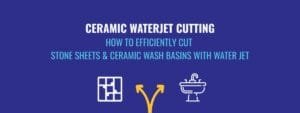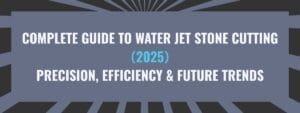Water Jet Machine is an advanced industrial cutting tool that has revolutionized the manufacturing and fabrication landscape. Utilizing ultra-high-pressure streams of water—sometimes combined with abrasives—it delivers accurate, clean cuts across a wide range of materials. From aerospace and automotive to metal fabrication and stone processing, this versatile machine is reshaping how industries handle complex cutting tasks. is an advanced industrial cutting tool that has revolutionized the manufacturing and fabrication landscape. Utilizing ultra-high-pressure streams of water—sometimes combined with abrasives—it deliavers accurate, clean cuts across a wide range of materials. From aerospace and automotive to metal fabrication and stone processing, this versatile machine is reshaping how industries handle complex cutting tasks.
Water Jet Machine: Definition and Core Components
Water Jet Machine refers to a cutting system that uses a high-speed jet of water, often pressurized up to 90,000 psi, to slice through various materials. When abrasives such as garnet or aluminum oxide are added to the stream, it can cut through hard materials like metal, stone, glass, and composites with exceptional precision.
A standard water jet machine includes several critical components:
- High-pressure pump: Generates the required pressure (typically 20,000–90,000 psi).
- Precision nozzle: Focuses the water stream into a narrow, powerful jet.
- Abrasive feeding system: Introduced in abrasive water jet models for enhanced cutting power.
- CNC control panel: Guides the cutting path based on programmed inputs.
- Worktable: Supports the material being processed and allows for movement in multiple axes.
This combination allows for precise, cold-cutting capabilities that avoid the thermal distortion common with traditional tools.
Water Jet Machine: Working Process Step-by-Step
Water Jet Machine operation follows a well-orchestrated sequence of processes to ensure clean, efficient cuts: operation follows a well-orchestrated sequence of processes to ensure clean, efficient cuts:
- Water Intake & Filtration: Water is drawn from a storage reservoir and filtered to remove particulates that may damage internal components.
- Pressurization: The high-pressure pump intensifies the water to the desired psi level.
- Abrasive Mixing: For hard materials, abrasives are introduced just before the water exits the nozzle.
- Precision Cutting: The CNC system moves the nozzle along the pre-programmed path, executing complex shapes and contours.
- Material Erosion: The high-pressure jet impacts the material, gradually eroding it without generating heat.
- Waste Collection & Recycling: Spent water and abrasive are collected and can be filtered for reuse, reducing environmental impact.
This cold-cutting method is particularly beneficial for sensitive materials or applications where heat-affected zones (HAZ) must be avoided.
Water Jet Machine: Comparison with Traditional Cutting Equipment
Water Jet Machine technology holds several advantages over traditional cutting methods such as plasma, laser, or mechanical saws. The comparison below outlines the key differences: technology holds several advantages over traditional cutting methods such as plasma, laser, or mechanical saws. The comparison below outlines the key differences:
| Feature | Water Jet Machine | Traditional Cutting (Laser/Plasma) |
|---|---|---|
| Heat Generation | None | High, causing Heat-Affected Zones (HAZ) |
| Material Versatility | Cuts almost all materials | Limited to certain types |
| Edge Quality | Smooth, burr-free edges | Often requires post-processing |
| Environmental Impact | Low (uses water, minimal fumes) | High (toxic emissions, noise, heat) |
| Safety Risk | Low (no flames or fumes) | Higher due to heat and sparks |
For instance, while a plasma cutter may be faster on thin metals, it leaves thermal damage and dross that require grinding. In contrast, a water jet machine cuts cleanly through thick stainless steel or laminated glass with no secondary processing required.
Water Jet Machine: Maintenance Essentials
Water Jet Machine reliability depends on proper and consistent maintenance. Ignoring routine service can lead to performance drops or expensive repairs. Here are key maintenance tasks: reliability depends on proper and consistent maintenance. Ignoring routine service can lead to performance drops or expensive repairs. Here are key maintenance tasks:
- Nozzle Inspection: Examine every 50–100 operational hours. Replace if orifice diameter increases by more than 0.001 inches.
- Pump Maintenance: Replace hydraulic fluid every 500 hours; inspect seals and check valves for leaks monthly.
- Abrasive System Cleaning: Clean delivery tubes and hoppers weekly to prevent abrasive flow interruptions.
- Water Filtration System: Change filters every 200 hours to avoid contaminant damage.
Regular maintenance ensures longevity, efficiency, and consistent cutting quality.
Water Jet Machine: Future Trends and Innovations
Water Jet Machine technology continues to evolve, driven by demands for higher precision, speed, and efficiency. Emerging trends include: technology continues to evolve, driven by demands for higher precision, speed, and efficiency. Emerging trends include:
- AI and Automation: New machines are integrating AI-driven diagnostics, auto-calibration, and predictive maintenance to reduce operator involvement.
- Enhanced Pressure Capabilities: Pumps exceeding 100,000 psi are now being developed to handle ultra-thick materials faster than ever.
- Energy-Efficient Designs: Innovations are lowering power usage by 15–20%, making water jets more sustainable.
- Portable Units: Lightweight, mobile water jet machines are enabling on-site use in construction, pipeline repair, and emergency rescue.
These developments signal that water jet technology will continue leading the charge in precision, safety, and adaptability across industries.
The Water Jet Machine is far more than a cutting tool—it is a comprehensive solution for industries seeking precision without compromise. With its cold-cutting capabilities, material flexibility, minimal environmental impact, and ongoing technological innovation, it’s no wonder water jets are becoming a staple in modern production lines. As automation and efficiency trends grow, investing in water jet systems offers manufacturers a competitive edge that lasts. is far more than a cutting tool—it is a comprehensive solution for industries seeking precision without compromise. With its cold-cutting capabilities, material flexibility, minimal environmental impact, and ongoing technological innovation, it’s no wonder water jets are becoming a staple in modern production lines. As automation and efficiency trends grow, investing in water jet systems offers manufacturers a competitive edge that lasts.



